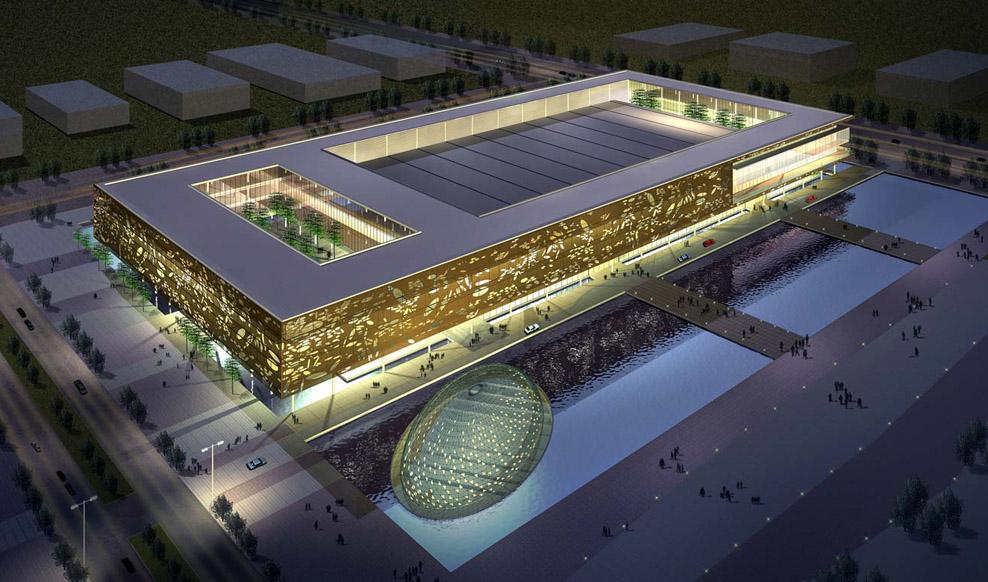Estimated reading time: 5 min
As we see repeatedly in the modern world – from dated business models to social media platforms – if something doesn’t update then it can quickly become obsolete. ‘Adapt or die’, the saying goes. The ‘tried and true’ methods of the past certainly hold an allure for many: businesses, organisers and indeed architects. These methods breed stability and certainty for everyone involved. But ‘tried and true’ isn’t the mantra of forward thinkers and never has been. With technology playing a crucial role in how we interact with our surroundings but also how we see it, there is no doubt that we’re currently experiencing a truly unique moment in our evolution. The physical and digital have integrated in a way that we could never have previously imagined. How architects embrace this new, rapidly changing, future will shape not only the world around us in the 21st century but also, significantly, their own relevance within it.

The China National Convention Centre by RMJM
Space
The convention centres of old were principally designed around a ‘lecture-style’ layout that encouraged little collaboration or engagement beyond audience members being asked to shout their questions a little louder or, if they were lucky, being passed a microphone. And while this has begun to change, a visit to Las Vegas (where 6 million delegates convene for conventions each year) shows it is essentially the same as it was twenty years ago barring superficial upgrades. How, then, will these spaces look in the future? How do we design spaces for activities that haven’t even been conceived yet?
The arrival of E-sports, for instance, has meant that exhibition centres and now even stadiums are being redesigned for a ‘sport’ that even two years ago would have been too small to be considered niche. Versatility, then, is key but on its own that isn’t nearly enough. Functionality is, perhaps, most important. The majority of buildings are designed with a single tenant in mind no matter how many people us it. A convention centre differs as its occupiers rotate on a daily basis with each demanding flexibility and specific requirements. This was emphasised when the biggest media centre in Olympic history transformed into the China National Convention Centre within one year. Of course, while that was always the plan, it doesn’t make the successful re-opening any less impressive. The state-of-the-art building set a new standard for convention centres and remains one of the most popular buildings in Beijing, one of the world’s most forward thinking cities. The underlines the point that the city, or setting, is fundamental to RMJM’s approach to convention centres. The China National Convention Centre scooped numerous awards upon completion and was noted for its distinctive engagement with local culture, something RMJM holds dear. RMJM’s architects believe that the best convention centres reflect their unique locations, the cultures they inhabit and the events they hold. The idea of merging practicality with emotion runs through their core.

RMJM’s Kolkata International Convention Centre
Digital
The integration of the physical and the digital has long been discussed but has truly taken hold this decade. Architecture has always helped push technology, at it’s very core it is an industry concerned with pushing boundaries. Digital design practice is now commonplace even amongst the smallest architectural firms who use computer modelling, simulation and programming to create both virtual and physical structures. Of course, the most advanced breakthrough has already happened with the advent of 3D printing. Over the past 15 years, 3D printing has evolved from a novelty technology to a sophisticated process with seemingly endless possibilities. If it is to help architects deliver projects quicker than ever before then its impact will be profound. Jack Cheng, professor at the Hong Kong University of Science and Technology, said recently: “I think it’s real, practical technologically. It’s possible to print an entire city but, of course, it will depend on the speed. Concrete is not like plastic.”
Multi-Experience
RMJM’s Kolkata International Convention Centre threatens to set a new benchmark in what we’ll come to expect from convention centres in the future. The Kolkata International Convention Centre is the core of a 100-acre site, also designed by RMJM, on the eastern outskirts of the city. The project is one one of the largest mixed-use developments to be commissioned in India. The exterior of the building features a secondary skin that acts as both an environmental filter and a giant digital screen that displays abstract cultural Bengali-inspired patterns. This 180-metre long screen also functions as a projection surface to display live events occurring within the centre itself. The main purpose hall straddles revolutionary open-air exhibition areas, each capable of holding unto 2000 delegates.
These multi-experience convention centres in Beijing and Kolkata offer a tantalising glimpse of the future RMJM sees for the convention centre. The shift towards a more user-focused design underpins a more interactive conference experience that is increasingly commonplace. This interaction will be the new currency at conventions going forward and the multi-experience venue will be the new convention typology.


